Spring Boot Security And JSON Web Token
Spring Boot Security And JSON Web Token 说明
流程说明
何时生成和使用jwt,其实我们主要是token更有意义并携带一些信息
https://github.com/Ants-double/huanhuncao/tree/master/visio
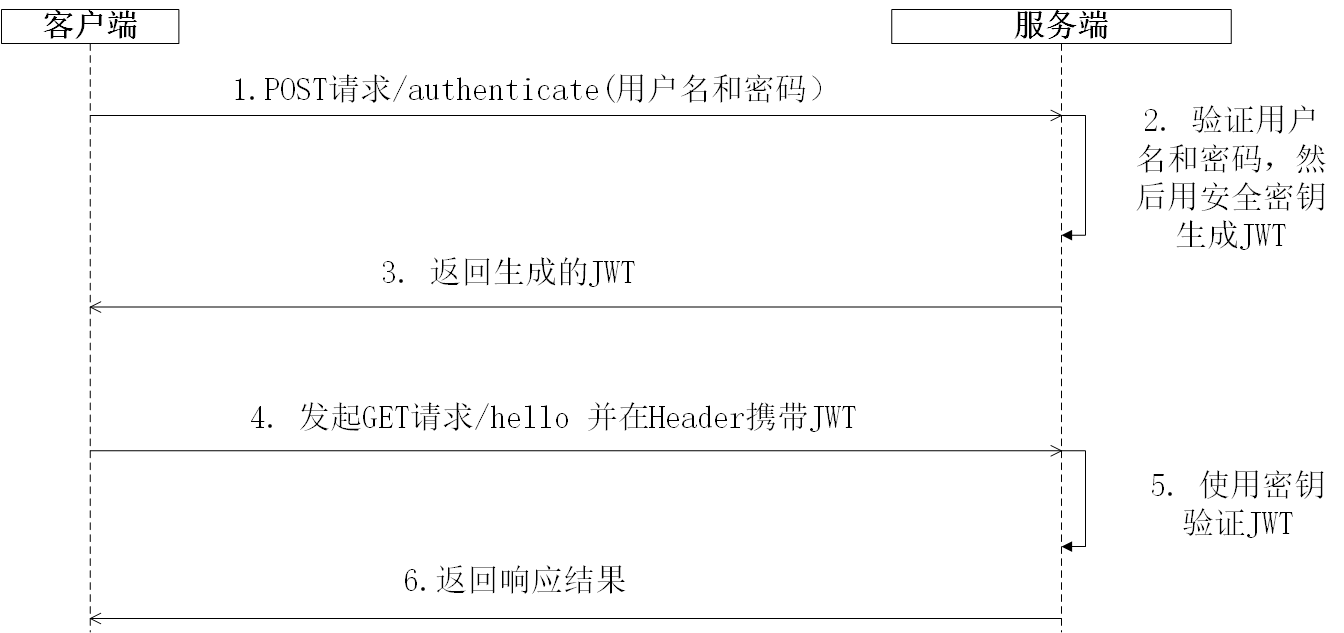
实操准备
新建一个spring boot 项目,并添加hello请求
工程目录结构如下
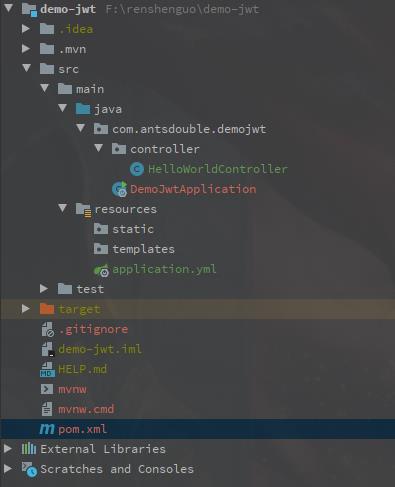
- HelloWorldController 代码如下
package com.antsdouble.demojwt.controller; import org.springframework.web.bind.annotation.GetMapping;
import org.springframework.web.bind.annotation.RestController; @RestController
public class HelloWorldController { @GetMapping(value = {"/hello"})
public String hello() {
return "Hello World JWT";
}
}
- 请求结果

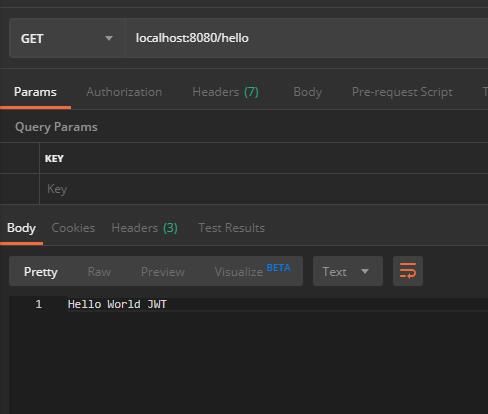
配置Spring Security 和JWT
完整 的pom.xml
<?xml version="1.0" encoding="UTF-8"?>
<project xmlns="http://maven.apache.org/POM/4.0.0" xmlns:xsi="http://www.w3.org/2001/XMLSchema-instance"
xsi:schemaLocation="http://maven.apache.org/POM/4.0.0 https://maven.apache.org/xsd/maven-4.0.0.xsd">
<modelVersion>4.0.0</modelVersion>
<parent>
<groupId>org.springframework.boot</groupId>
<artifactId>spring-boot-starter-parent</artifactId>
<version>2.2.0.RELEASE</version>
<relativePath/> <!-- lookup parent from repository -->
</parent>
<groupId>com.antsdouble</groupId>
<artifactId>demo-jwt</artifactId>
<version>0.0.1-SNAPSHOT</version>
<name>demo-jwt</name>
<description>Demo project for Spring Boot</description>
<properties>
<project.build.sourceEncoding>UTF-8</project.build.sourceEncoding>
<project.reporting.outputEncoding>UTF-8</project.reporting.outputEncoding>
<java.version>1.8</java.version>
</properties> <dependencies>
<dependency>
<groupId>org.springframework.boot</groupId>
<artifactId>spring-boot-starter-web</artifactId>
</dependency> <dependency>
<groupId>org.springframework.boot</groupId>
<artifactId>spring-boot-starter-test</artifactId>
<scope>test</scope>
<exclusions>
<exclusion>
<groupId>org.junit.vintage</groupId>
<artifactId>junit-vintage-engine</artifactId>
</exclusion>
</exclusions>
</dependency>
<dependency>
<groupId>org.springframework.boot</groupId>
<artifactId>spring-boot-starter-security</artifactId>
</dependency>
<dependency>
<groupId>io.jsonwebtoken</groupId>
<artifactId>jjwt</artifactId>
<version>0.9.1</version>
</dependency>
<dependency>
<groupId>org.springframework.boot</groupId>
<artifactId>spring-boot-starter-data-jpa</artifactId>
</dependency>
<dependency>
<groupId>mysql</groupId>
<artifactId>mysql-connector-java</artifactId>
</dependency>
</dependencies> <build>
<plugins>
<plugin>
<groupId>org.springframework.boot</groupId>
<artifactId>spring-boot-maven-plugin</artifactId>
</plugin>
</plugins>
</build> </project>
生成jwt
https://github.com/Ants-double/huanhuncao/tree/master/visio
如果请求authenticate 则会生成jwt
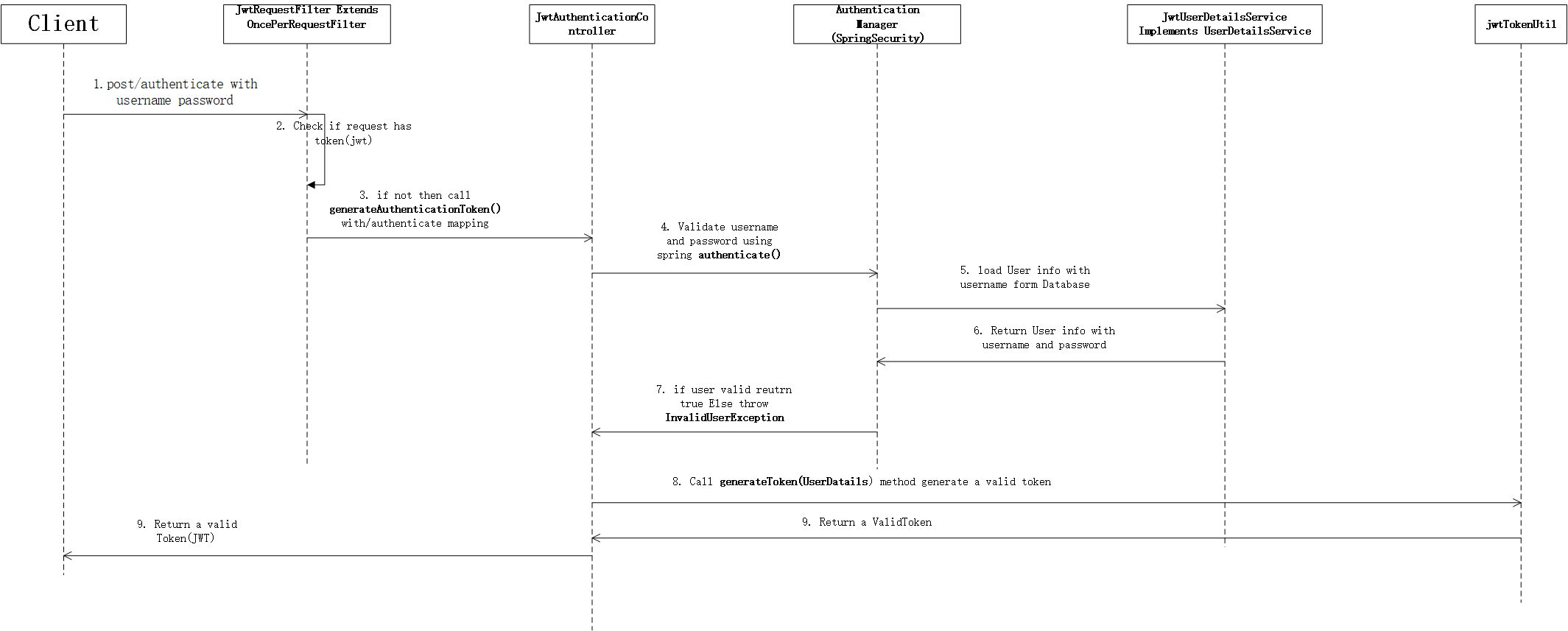
检证 jwt
https://github.com/Ants-double/huanhuncao/tree/master/visio
1. 请求业务接口带上jwt 先验证通过后再处理具体的请求
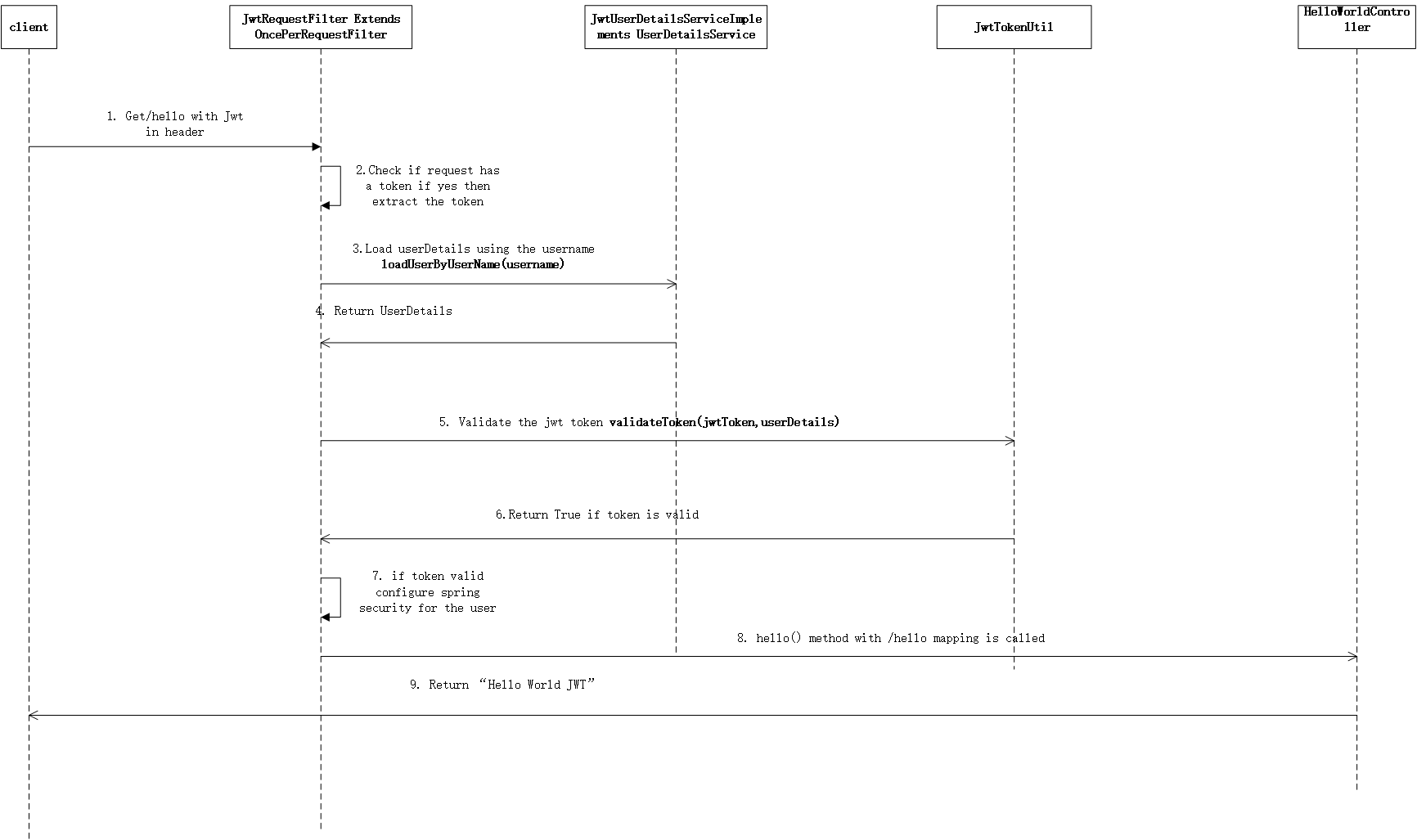
配置数据库相关
application.yml
jwt:
secret: javainuse
spring:
datasource:
url: jdbc:mysql://localhost:3306/test?useUnicode=true&characterEncoding=utf-8&useSSL=false&serverTimezone=CTT
username: root
password: 456123
platform: mysql
jpa:
hibernate:
ddl-auto: create-drop
添加对应的DTO 和DAO
package com.antsdouble.demojwt.model; /**
* @author lyy
* @Deprecated
* @date 2019/10/17
*/
public class UserDTO {
private String username;
private String password; public String getUsername() {
return username;
} public void setUsername(String username) {
this.username = username;
} public String getPassword() {
return password;
} public void setPassword(String password) {
this.password = password;
}
}package com.antsdouble.demojwt.dao; import com.antsdouble.demojwt.model.DAOUser;
import org.springframework.data.repository.CrudRepository;
import org.springframework.stereotype.Repository; /**
* @author lyy
* @Deprecated
* @date 2019/10/17
*/ @Repository
public interface UserDao extends CrudRepository<DAOUser, Integer> {
DAOUser findByUsername(String username);
}- JwtAuthenticationController
package com.antsdouble.demojwt.controller; import com.antsdouble.demojwt.config.JwtTokenUtil;
import com.antsdouble.demojwt.model.JwtRequest;
import com.antsdouble.demojwt.model.JwtResponse;
import com.antsdouble.demojwt.model.UserDTO;
import com.antsdouble.demojwt.service.JwtUserDetailsService;
import org.springframework.beans.factory.annotation.Autowired;
import org.springframework.http.ResponseEntity;
import org.springframework.security.authentication.AuthenticationManager;
import org.springframework.security.authentication.BadCredentialsException;
import org.springframework.security.authentication.DisabledException;
import org.springframework.security.authentication.UsernamePasswordAuthenticationToken;
import org.springframework.security.core.userdetails.UserDetails;
import org.springframework.web.bind.annotation.*; /**
* @author lyy
* @Deprecated
* @date 2019/10/17
*/
@RestController
@CrossOrigin
public class JwtAuthenticationController {
@Autowired
private AuthenticationManager authenticationManager;
@Autowired
private JwtTokenUtil jwtTokenUtil;
@Autowired
private JwtUserDetailsService userDetailsService;
@RequestMapping(value = "/authenticate", method = RequestMethod.POST)
public ResponseEntity<?> createAuthenticationToken(@RequestBody JwtRequest authenticationRequest) throws Exception {
authenticate(authenticationRequest.getUsername(), authenticationRequest.getPassword());
final UserDetails userDetails = userDetailsService
.loadUserByUsername(authenticationRequest.getUsername());
final String token = jwtTokenUtil.generateToken(userDetails);
return ResponseEntity.ok(new JwtResponse(token));
}
@RequestMapping(value = "/register", method = RequestMethod.POST)
public ResponseEntity<?> saveUser(@RequestBody UserDTO user) throws Exception {
return ResponseEntity.ok(userDetailsService.save(user));
}
private void authenticate(String username, String password) throws Exception {
try {
authenticationManager.authenticate(new UsernamePasswordAuthenticationToken(username, password));
} catch (DisabledException e) {
throw new Exception("USER_DISABLED", e);
} catch (BadCredentialsException e) {
throw new Exception("INVALID_CREDENTIALS", e);
}
}
}- WebSecurityConfig
package com.antsdouble.demojwt.config; import org.springframework.beans.factory.annotation.Autowired;
import org.springframework.context.annotation.Bean;
import org.springframework.context.annotation.Configuration;
import org.springframework.http.HttpMethod;
import org.springframework.security.authentication.AuthenticationManager;
import org.springframework.security.config.annotation.authentication.builders.AuthenticationManagerBuilder;
import org.springframework.security.config.annotation.method.configuration.EnableGlobalMethodSecurity;
import org.springframework.security.config.annotation.web.builders.HttpSecurity;
import org.springframework.security.config.annotation.web.configuration.EnableWebSecurity;
import org.springframework.security.config.annotation.web.configuration.WebSecurityConfigurerAdapter;
import org.springframework.security.config.http.SessionCreationPolicy;
import org.springframework.security.core.userdetails.UserDetailsService;
import org.springframework.security.crypto.bcrypt.BCryptPasswordEncoder;
import org.springframework.security.crypto.password.PasswordEncoder;
import org.springframework.security.web.authentication.UsernamePasswordAuthenticationFilter; /**
* @author lyy
* @Deprecated
* @date 2019/10/17
*/
@Configuration
@EnableWebSecurity
@EnableGlobalMethodSecurity(prePostEnabled = true)
public class WebSecurityConfig extends WebSecurityConfigurerAdapter {
@Autowired
private JwtAuthenticationEntryPoint jwtAuthenticationEntryPoint;
@Autowired
private UserDetailsService jwtUserDetailsService;
@Autowired
private JwtRequestFilter jwtRequestFilter;
@Autowired
public void configureGlobal(AuthenticationManagerBuilder auth) throws Exception {
// configure AuthenticationManager so that it knows from where to load
// user for matching credentials
// Use BCryptPasswordEncoder
auth.userDetailsService(jwtUserDetailsService).passwordEncoder(passwordEncoder());
}
@Bean
public PasswordEncoder passwordEncoder() {
return new BCryptPasswordEncoder();
}
@Bean
@Override
public AuthenticationManager authenticationManagerBean() throws Exception {
return super.authenticationManagerBean();
}
@Override
protected void configure(HttpSecurity httpSecurity) throws Exception {
// We don't need CSRF for this example
httpSecurity.csrf().disable()
// dont authenticate this particular request
.authorizeRequests().antMatchers("/authenticate", "/register").
permitAll().antMatchers(HttpMethod.OPTIONS, "/**")
.permitAll().
// all other requests need to be authenticated
anyRequest().authenticated().and().
// make sure we use stateless session; session won't be used to
// store user's state.
exceptionHandling().authenticationEntryPoint(jwtAuthenticationEntryPoint).and().sessionManagement()
.sessionCreationPolicy(SessionCreationPolicy.STATELESS);
// Add a filter to validate the tokens with every request
httpSecurity.addFilterBefore(jwtRequestFilter, UsernamePasswordAuthenticationFilter.class);
}
}- JwtTokenUtil
package com.antsdouble.demojwt.config; import io.jsonwebtoken.Claims;
import io.jsonwebtoken.Jwts;
import io.jsonwebtoken.SignatureAlgorithm;
import org.springframework.beans.factory.annotation.Value;
import org.springframework.security.core.userdetails.UserDetails;
import org.springframework.stereotype.Component; import java.io.Serializable;
import java.util.Date;
import java.util.HashMap;
import java.util.Map;
import java.util.function.Function; /**
* @author lyy
* @Deprecated
* @date 2019/10/17
*/
@Component
public class JwtTokenUtil implements Serializable {
private static final long serialVersionUID = -2550185165626007488L;
public static final long JWT_TOKEN_VALIDITY = 5 * 60 * 60;
@Value("${jwt.secret}")
private String secret; //retrieve username from jwt token
public String getUsernameFromToken(String token) {
return getClaimFromToken(token, Claims::getSubject);
} //retrieve expiration date from jwt token
public Date getExpirationDateFromToken(String token) {
return getClaimFromToken(token, Claims::getExpiration);
} public <T> T getClaimFromToken(String token, Function<Claims, T> claimsResolver) {
final Claims claims = getAllClaimsFromToken(token);
return claimsResolver.apply(claims);
} //for retrieveing any information from token we will need the secret key
private Claims getAllClaimsFromToken(String token) {
return Jwts.parser().setSigningKey(secret).parseClaimsJws(token).getBody();
} //check if the token has expired
private Boolean isTokenExpired(String token) {
final Date expiration = getExpirationDateFromToken(token);
return expiration.before(new Date());
} //generate token for user
public String generateToken(UserDetails userDetails) {
Map<String, Object> claims = new HashMap<>();
return doGenerateToken(claims, userDetails.getUsername());
} //while creating the token -
//1. Define claims of the token, like Issuer, Expiration, Subject, and the ID
//2. Sign the JWT using the HS512 algorithm and secret key.
//3. According to JWS Compact Serialization(https://tools.ietf.org/html/draft-ietf-jose-json-web-signature-41#section-3.1)
// compaction of the JWT to a URL-safe string
private String doGenerateToken(Map<String, Object> claims, String subject) {
return Jwts.builder().setClaims(claims).setSubject(subject).setIssuedAt(new Date(System.currentTimeMillis()))
.setExpiration(new Date(System.currentTimeMillis() + JWT_TOKEN_VALIDITY * 1000))
.signWith(SignatureAlgorithm.HS512, secret).compact();
} //validate token
public Boolean validateToken(String token, UserDetails userDetails) {
final String username = getUsernameFromToken(token);
return (username.equals(userDetails.getUsername()) && !isTokenExpired(token));
}
}- JwtRequestFilter
package com.antsdouble.demojwt.config; import com.antsdouble.demojwt.service.JwtUserDetailsService;
import io.jsonwebtoken.ExpiredJwtException;
import org.springframework.beans.factory.annotation.Autowired;
import org.springframework.security.authentication.UsernamePasswordAuthenticationToken;
import org.springframework.security.core.context.SecurityContextHolder;
import org.springframework.security.core.userdetails.UserDetails;
import org.springframework.security.web.authentication.WebAuthenticationDetailsSource;
import org.springframework.stereotype.Component;
import org.springframework.web.filter.OncePerRequestFilter; import javax.servlet.FilterChain;
import javax.servlet.ServletException;
import javax.servlet.http.HttpServletRequest;
import javax.servlet.http.HttpServletResponse;
import java.io.IOException; /**
* @author lyy
* @Deprecated
* @date 2019/10/17
*/
@Component
public class JwtRequestFilter extends OncePerRequestFilter {
@Autowired
private JwtUserDetailsService jwtUserDetailsService;
@Autowired
private JwtTokenUtil jwtTokenUtil; @Override
protected void doFilterInternal(HttpServletRequest request, HttpServletResponse response, FilterChain chain)
throws ServletException, IOException {
final String requestTokenHeader = request.getHeader("Authorization");
String username = null;
String jwtToken = null;
// JWT Token is in the form "Bearer token". Remove Bearer word and get
// only the Token
if (requestTokenHeader != null && requestTokenHeader.startsWith("Bearer ")) {
jwtToken = requestTokenHeader.substring(7);
try {
username = jwtTokenUtil.getUsernameFromToken(jwtToken);
} catch (IllegalArgumentException e) {
System.out.println("Unable to get JWT Token");
} catch (ExpiredJwtException e) {
System.out.println("JWT Token has expired");
}
catch (Exception e){
System.out.println(e);
}
} else {
logger.warn("JWT Token does not begin with Bearer String");
}
// Once we get the token validate it.
if (username != null && SecurityContextHolder.getContext().getAuthentication() == null) {
UserDetails userDetails = this.jwtUserDetailsService.loadUserByUsername(username);
// if token is valid configure Spring Security to manually set
// authentication
if (jwtTokenUtil.validateToken(jwtToken, userDetails)) {
UsernamePasswordAuthenticationToken usernamePasswordAuthenticationToken = new UsernamePasswordAuthenticationToken(
userDetails, null, userDetails.getAuthorities());
usernamePasswordAuthenticationToken
.setDetails(new WebAuthenticationDetailsSource().buildDetails(request));
// After setting the Authentication in the context, we specify
// that the current user is authenticated. So it passes the
// Spring Security Configurations successfully.
SecurityContextHolder.getContext().setAuthentication(usernamePasswordAuthenticationToken);
}
}
chain.doFilter(request, response);
}
}- JwtAuthenticationEntryPoint
package com.antsdouble.demojwt.config; import org.springframework.security.core.AuthenticationException;
import org.springframework.security.web.AuthenticationEntryPoint;
import org.springframework.stereotype.Component; import javax.servlet.http.HttpServletRequest;
import javax.servlet.http.HttpServletResponse;
import java.io.IOException;
import java.io.Serializable; /**
* @author lyy
* @Deprecated
* @date 2019/10/17
*/
@Component
public class JwtAuthenticationEntryPoint implements AuthenticationEntryPoint, Serializable { private static final long serialVersionUID = -7858869558953243875L;
@Override
public void commence(HttpServletRequest request, HttpServletResponse response,
AuthenticationException authException) throws IOException {
response.sendError(HttpServletResponse.SC_UNAUTHORIZED, "Unauthorized");
}
}
请求测试
- localhost:8080/register
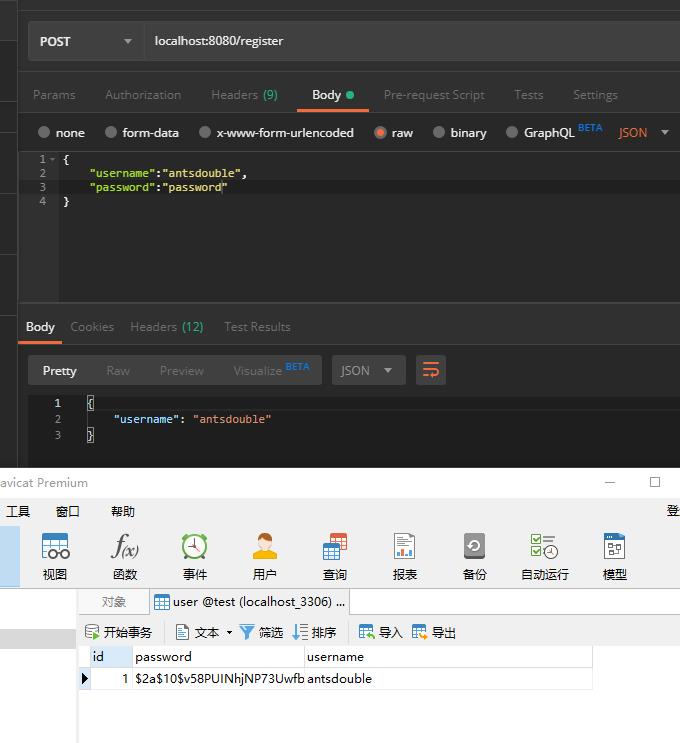
- localhost:8080/authenticate
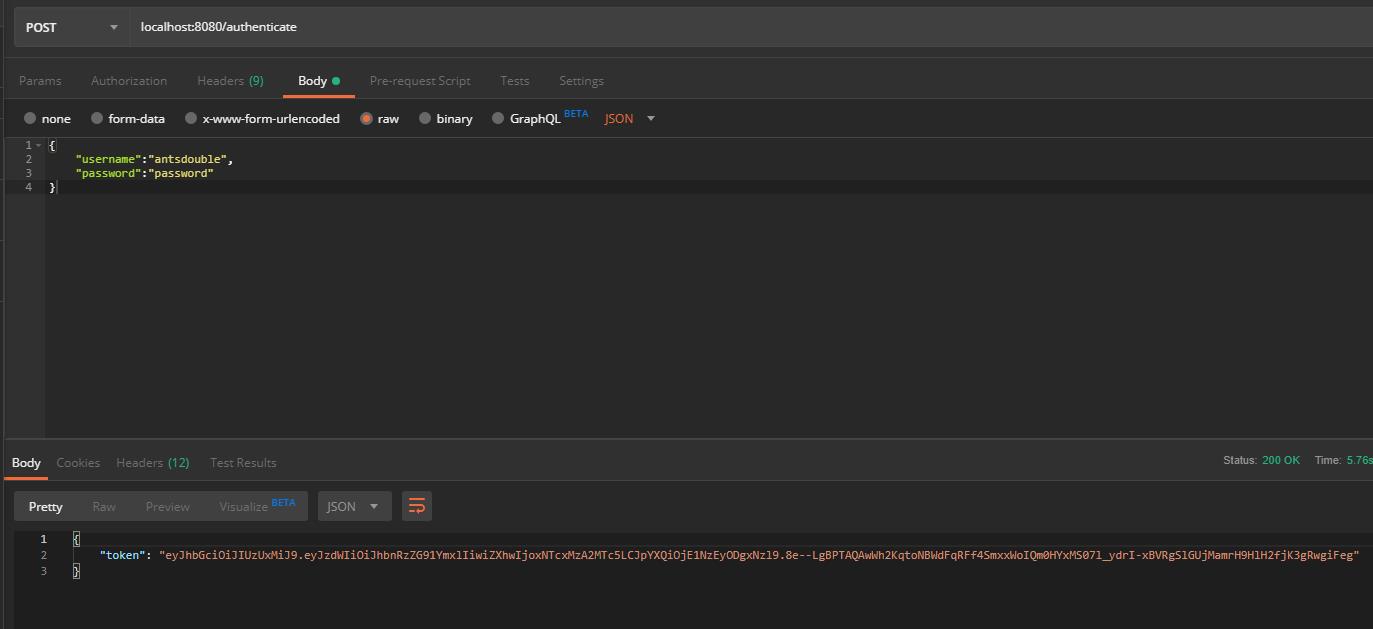
- localhost:8080/hello
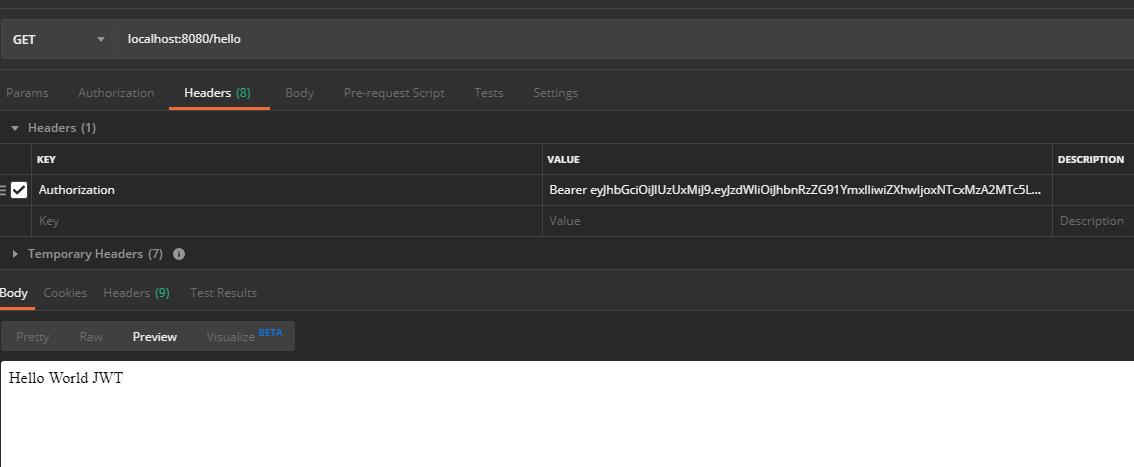
参考文档
https://dzone.com/articles/spring-boot-security-json-web-tokenjwt-hello-world
Spring Boot Security And JSON Web Token的更多相关文章
- [更新]一份包含: 采用RSA JWT(Json Web Token, RSA加密)的OAUTH2.0,HTTP BASIC,本地数据库验证,Windows域验证,单点登录的Spring Security配置文件
没有任何注释,表怪我(¬_¬) 更新: 2016.05.29: 将AuthorizationServer和ResourceServer分开配置 2016.05.29: Token获取采用Http Ba ...
- Spring Boot集成JSON Web Token(JWT)
一:认证 在了解JWT之前先来回顾一下传统session认证和基于token认证. 1.1 传统session认证 http协议是一种无状态协议,即浏览器发送请求到服务器,服务器是不知道这个请求是哪个 ...
- Java JWT: JSON Web Token
Java JWT: JSON Web Token for Java and Android JJWT aims to be the easiest to use and understand libr ...
- Spring Boot Security 整合 JWT 实现 无状态的分布式API接口
简介 JSON Web Token(缩写 JWT)是目前最流行的跨域认证解决方案.JSON Web Token 入门教程 - 阮一峰,这篇文章可以帮你了解JWT的概念.本文重点讲解Spring Boo ...
- Spring Boot Security JWT 整合实现前后端分离认证示例
前面两章节我们介绍了 Spring Boot Security 快速入门 和 Spring Boot JWT 快速入门,本章节使用 JWT 和 Spring Boot Security 构件一个前后端 ...
- 如何在SpringBoot中集成JWT(JSON Web Token)鉴权
这篇博客主要是简单介绍了一下什么是JWT,以及如何在Spring Boot项目中使用JWT(JSON Web Token). 1.关于JWT 1.1 什么是JWT 老生常谈的开头,我们要用这样一种工具 ...
- JSON Web Token – 在 Web 应用间安全地传递信息
出处:子回 使用 JWT 令牌和 Spring Security 来实现身份验证 八幅漫画理解使用JSON Web Token设计单点登录系统
- JWT—JSON Web Token - 理解JWT网络间应用用户安全认证交互设计
原文地址:http://blog.leapoahead.com/2015/09/06/understanding-jwt/ 官网地址:https://jwt.io/ JSON Web Token(JW ...
- 你知道你对 JSON Web Token 的认识存在误解吗
1.前言 JSON Web Token (JWT) 其实目前已经广为软件开发者所熟知了,但是 JOSE (Javascript Object Signing and Encryption) 却鲜有人知 ...
随机推荐
- 树莓派3安装openwrt
1.在编译openwrt之前,需要先安装依赖包,命令如下: sudo apt-get install autoconf binutils bison bzip2 flex gawk gettext m ...
- .Net Core WebApi(二)在Windows服务器上部署
上一篇学习到了如何简单的创建.Net Core Api和Swagger使用,既然写了接口,那么就需要部署到服务器上才能够正式使用.服务器主要用到了两种系统,Windows和Linux,.Net和Win ...
- 首次GitHub千星项目提交维护成功 留念
现在有点激动,可能有混乱的地方.请大家见谅. 一直觉得千星项目,对我来说是一个遥不可及的地方.没想到第一次在GitHub上 提交Pull Request 就成功了,并且是一个千星项目. 虽然 只是提出 ...
- C++ 函数模板用法
泛型编程概念:不考虑具体数据类型的编程方式: 函数模板: 1.提供一种特殊的函数可用不同类型进行调用: 2.与普通函数很相似,区别是类型可被参数化: template <typename T&g ...
- 夯实Java基础系列10:深入理解Java中的异常体系
目录 为什么要使用异常 异常基本定义 异常体系 初识异常 异常和错误 异常的处理方式 "不负责任"的throws 纠结的finally throw : JRE也使用的关键字 异常调 ...
- Android系统开发实务实训
实训项目 : Android系统开发实务实训 项目成品名称: 绝地坦克 ...
- 深入Dapper.NET源码 (文长)
目录 前言.目录.安装环境 Dynamic Query 原理 Part1 Dynamic Query 原理 Part2 Strongly Typed Mapping 原理 Part1 : ADO.NE ...
- 创建一个自己的Vue UI组件库,并将它发布在npm上
本文仅限于入门级,没有成规模制作,希望能对你有所帮助. 因为在开发多个项目中可能会用到同一个组件,那么我们通过复制粘贴的形式更新,无异于是笨拙的,我们可以通过上传到npm后,不断迭代npm包来实现更新 ...
- 【主动学习】Variational Adversarial Active Learning
本文记录了博主阅读ICCV2019一篇关于主动学习论文的笔记,第一篇博客,以后持续更新哈哈 论文题目:<Variational AdVersarial Active Learning> 原 ...
- asp.net core 使用 AccessControlHelper 控制访问权限
asp.net core 使用 AccessControlHelper 控制访问权限 Intro 由于项目需要,需要在基于 asp.net mvc 的 Web 项目框架中做权限的控制,于是才有了这个权 ...
